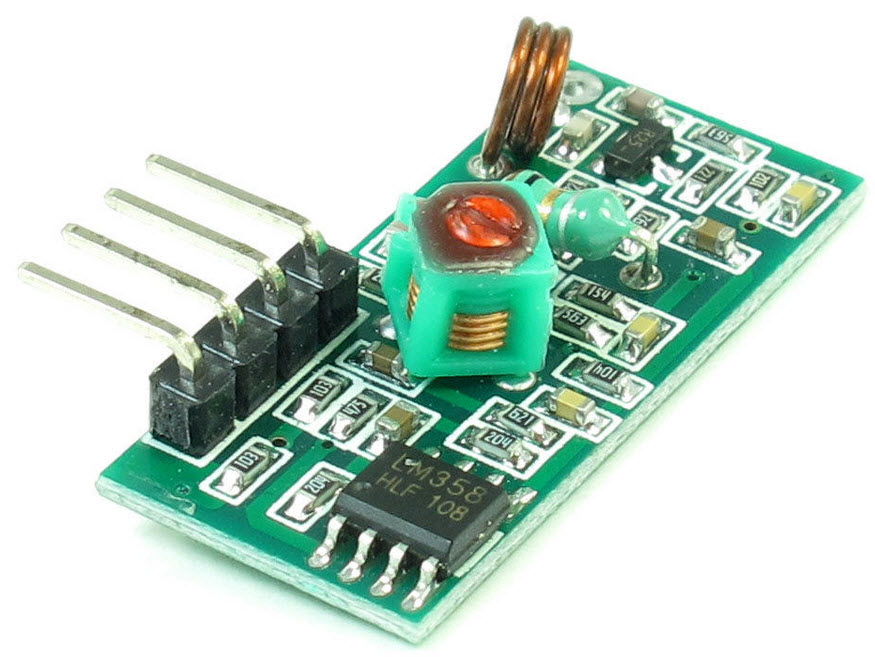I have two 433.92 RF receivers of type XY-MK-5V and one of type RXB12 . The question that brings we here is this:
Lets give the receivers names:
XY-MK-5V is Y as yellow
XY-MK-5V is O as orange
RXB12 is B as blue
When I connect them to an oscilloscope, B and Y behave in the same way, constantly giving the background noise and when I try sending a signal from a remote control, t is not so clear when the signal begins but I can distinguish it from the noise. So far, so good.
When I connect O, there is almost no background noise and when I try sending a signal from a remote control I can clearly see it. There is almost no noise at all.
So, could someone help me with understanding why O behaves like it has a built-in nose filter. I like and would like to have this type of hardware filter but since only 1 of 3 has it and this one from the group of two and another one does not have this filter, it sounds like there is a problem somewhere. Both were bought on the same day from the same supplier and came in the same package.
Here is the same thing in pictures. 3 readings are taken from 3 receivers via Blue, Yellow and Orange cables:
I am connecting 3 receivers to the oscilloscope, start recording, then press a button on the receiver and stopping the recording.
So, why does the Orange filter out the noise?
Thanks.
edit:
XY-MK-5V Documentation URL (Technical Parameters) Document
document content:
Technical Parameters
Operating voltage (V): DC5V
Quiescent Current (mA): 4MA
Modulation: AM (OOK)
Operating temperature: -10 ? ~ 70 ?
Receiver sensitivity (dBm):-105DB
Operating frequency (MHz): 315,433.92 MHz (266-433MHZ frequency band can
be optional)
Dimensions (LWH): 30 * 14 * 7mm
Requirements such as the pro distance farther, then 1/4 wavelength antenna,
generally use 50 ohm single-core wire, the length of the antenna 315M of
approximately 23cm, 433M is about 17cm;
Reception antenna location on the module also affects the installation,
the antenna as far as possible straight away from the shield, high pressure,
and interference source place;
receiving frequency used, decoding and
oscillation resistor should match with the launch
Pin and instructions for use:
The ANT connected antenna side
2 VCC power supply positive
3,4 the DATA data output
5 GND negative power
The receiver module has four external interfaces, VCC positive power
supply, "DATA" Output "GND" indicates the power supply negative (products
labeled in English).
Uses: remote control switch, receiver module, motorcycle, automobile
anti-theft products, household anti-theft products, electric doors,
shutter doors, windows, remote control socket, remote control the LED,
remote control stereo, remote control electric gate, garage door remote
control, remote control retractable doors, remote control volume gate ,
sliding door, remote control door opener, door closing device control
system, remote control curtains, alarm system, alarm, remote control
motorcycle, remote control electric cars, remote control MP3, remote
lights, remote control cars, security and other remote areas of civil and
industrial facilities
Quality characteristics:
1, the receiver module and fixed code on the market, the same frequency
remote control to learn the code any ancillary use, can be equipped with
all wireless remote control of the shop.
2, the super-regenerative receiver module LC oscillator circuit
containing zoom in shaping the output data signal is TTL level and can
be directly to the decoder is extremely easy to use, and inexpensive, so
widely used. Small size, high sensitivity, easy debugging; frequency,
short lead times; consistency of product quality, cost-effective, the
current is the amount of wireless remote control market is the largest
and most widely used form of high-frequency receiver module. Receiver
module has a wide receiver bandwidth, typically ± 10MHz, factory general
tone in the 315MHz or 433.92MHZ (if there are special requirements for
adjustable frequency, adjustment of the frequency range 266MHz ~ 433MHz.)
Receiver module with DC5V power supply generally, any special
requirements to adjust the voltage, the voltage adjustment range of 3 ~
8V.
For 4mA quiescent operating current of the receiver module factory
generally, if there are special requirements can reduce the current,
minimum current is adjustable to 1.5mA, but the receiver sensitivity will
be reduced. Factory receiver module output noise output, if any special
requirements can be changed without the noise output, but will reduce the
receiver sensitivity.



